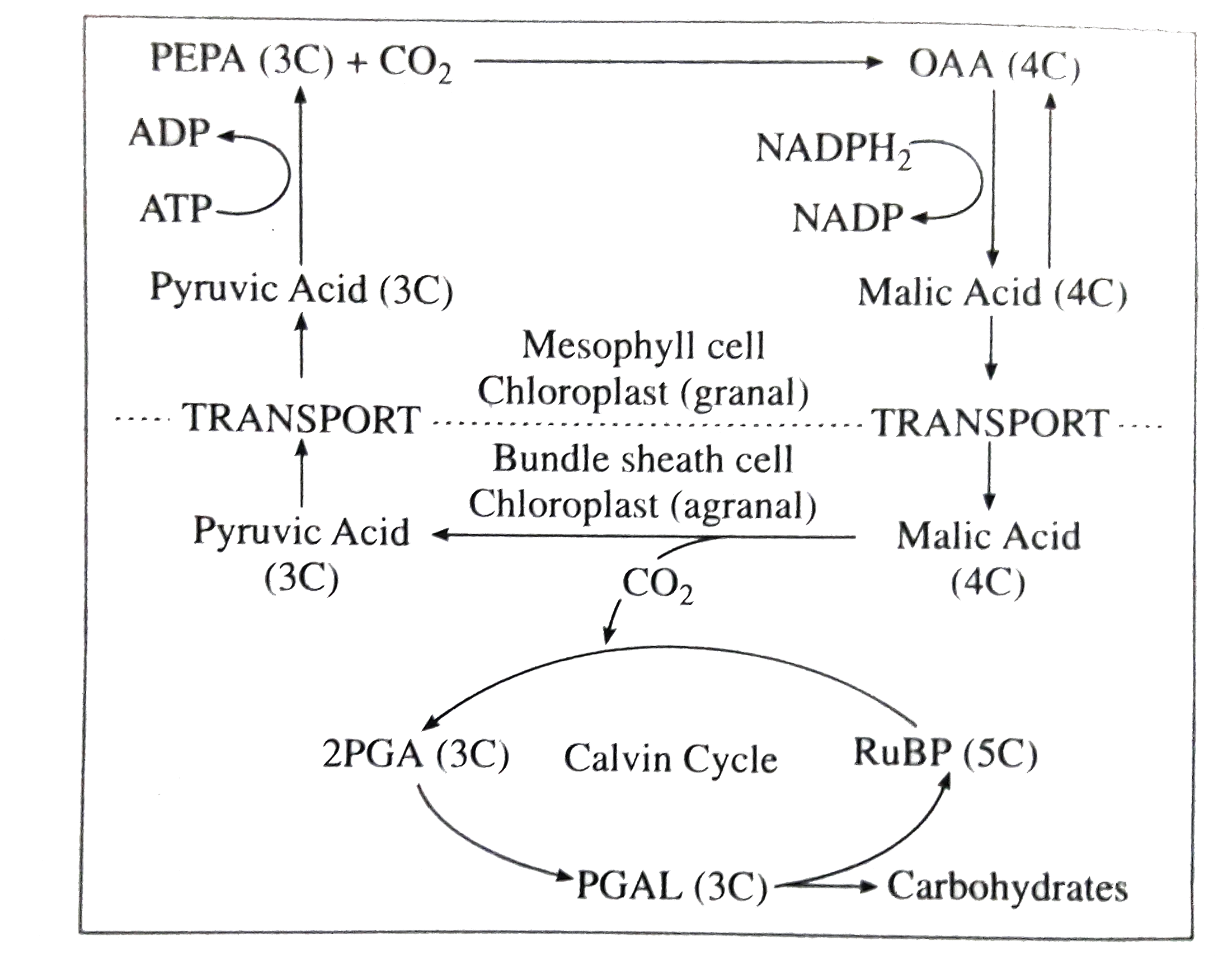In tropical plants like maize and sugarcane, during light independent reaction, Co2 is not directly absorbed by RuBisco. The follow another pathway. Explain that pathway.
Text Solution
(1) In tropical plants like maize, sugar cane, Jowar, Amaranthus, Atriplex, etc, there exists an alternative pathway of photosynthesis. This pathway is called HSK pathway of photosynthesis named after its discoverers, viz., Hatch, Slack and Kortschak.
(2) HSK pathway occurs in low concentration of CO2 as low as 10 ppm (parts per million) in the atmosphere.
(3) In HSK pathway, the initial product is a 4-carbon compound, i.e., oxaloacetic acid (oxalocetate). Therefore, this pathway of photosynthesis is also known as C4 pathway.
(4) The various reactions that occur during HSK pathway are completed in two parts at two different sites which are as follows :
(i) Reactions in mesophyll chloroplasts :
(1) Initially, the atmospheric carbon dioxide which enters the mesophyll chloroplasts is accepted by PEPA (phosphoenol pyruvic acid) a 3-carbon compound to form a 4-C compound called oxaloacetic acid in the presence of water and PEP carboxylase enzyme as shown below :
PEPA(C3)+CO2+H2OPEP carboxylase−−−−−−−−−→OAA+H3PO4(C4)
(2) Oxaloacetic acid is reduced to malic acid (malate) by the enzyme malate dehydrogenase in the presence of NADPH2 or changed aspartic acid by amination in the presence of NADPH2 and the enzyme transminase as shown below :
OAA+NADPH2Malate dehydrogenase−−−−−−−−−−−−→Malic acid(Malate)+NADP
OAA+NADPH2+NH3Transaminase−−−−−−−→Aspartic acid(Malate)+NADP+H2O
(ii) Reactions in bundle sheath chloroplasts :
(1) Malic or aspartic acid is then transported to the bundle sheath chloroplasts where it undergoes decarboxylation to form pyruvic acid (pyruvate) with the release of CO2 as shown below :
Malic acid(4C)+NADP→Pyruvic acid(Pyruvate)+CO2+(3C)NADPH2
(2) CO2 released in the above reaction is accepted by RuBP (second carbon acceptor). It enters the Calvin cycle and eventually forms glucose which is stored as starch in the bundle sheath chloroplasts.
(3) Pyruvic acid which is formed due to decarboxylation of malic acid is transported to mesophyll cells where it undergoes phosphorylation to regenerate PEPA as shown below :
Pyruvic(3C)+ATPPhosphorylation−−−−−−−−−→PEPA+ADP(3C)+iP
(4) From the above account it is abivous that in C4 plants, CO4 is fixed twice in two different cells during the daytime.

CO2 fixation in C4 plants can occur at very low concentrantions of CO2 i.e., as low as 1-2 parts per million. C4 plants can carry on photosynthesis enven if the light intensity is high, temperature is high and the amount of available water is less.
|
Topper's Solved these Questions
- LONG ANSWER QUESTIONSBOOK - NAVNEET PUBLICATION - MAHARASHTRA BOARDCHAPTER - LONG ANSWER QUESTIONSEXERCISE - Respiration
4 Videos
- LONG ANSWER QUESTIONSBOOK - NAVNEET PUBLICATION - MAHARASHTRA BOARDCHAPTER - LONG ANSWER QUESTIONSEXERCISE - Reproduction in Plants
9 Videos
- LONG ANSWER QUESTIONSBOOK - NAVNEET PUBLICATION - MAHARASHTRA BOARDCHAPTER - LONG ANSWER QUESTIONSEXERCISE - Gene : Its Nature, Expression and Regulation
6 Videos
- GIVE REASONS BOOK - NAVNEET PUBLICATION - MAHARASHTRA BOARDCHAPTER - GIVE REASONS EXERCISE - Organisms and Environment - II
2 Videos
- MATCH THE COLUMNS/MATCH THE PAIRS/COMPLETE THE TABLEBOOK - NAVNEET PUBLICATION - MAHARASHTRA BOARDCHAPTER - MATCH THE COLUMNS/MATCH THE PAIRS/COMPLETE THE TABLEEXERCISE - Chapter 19 : Organisms and Environment - II
3 Videos
Similar Questions
Knowledge Check
Tropical plants like sugarcane show high efficiency of CO2 fixation because of :
ACalvin cycleBHatch -Slack cycleCCyclic photophosphorylationDTCA CycleTropical plants like sugarcane show high efficiency of CO2 fixation because of :
ACalvin cycleBHatch-Slack cycleCCyclic photophosphorylationDTCA CycleTropical plants like maize show high efficiency of CO2 fixation because of
ATCA cycleBEMP pathwayCHatch-Slack cycleDCalvin cycle
Plants like sugarcane show high productivity and high efficiency of CO2 fixation, because of
View SolutionQ. Maize, sugarcane and some other tropical plants have high efficiency of CO2 fixation because they operate
View SolutionPlants like sugarcane show high productivity and high efficiency of CO2 fixation, because of
View SolutionWhich of the following is the correct pathway of absorbed water in the roots of plants?
View SolutionMaize, sugarcane and some other tropical plants have high efficiency of CO2 fixation because they operate
View Solution
